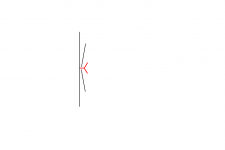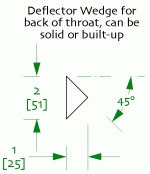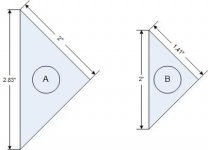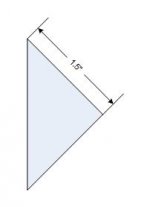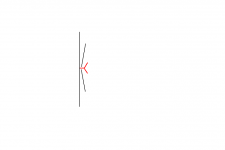Not at all. I was wondering when someone would raise this actually because it's not that obvious at first glace.
In a nutshell, it's the 'slit' that is actually the throat of the two expanding waveguides (or the internal CSA of the monster reflex vents if you prefer). The split into two separate paths forms the next stage of the expansion. This part is deliberately left relatively unsmoothed or bevelled because it helps disrupt any unwanted higher frequency leakage out through the vents. We've done something similar with the Nagaoka / Olson style cabinets, which have a single throat and initial expansion stage before splitting in two.
Hope that helps?
Scott
In a nutshell, it's the 'slit' that is actually the throat of the two expanding waveguides (or the internal CSA of the monster reflex vents if you prefer). The split into two separate paths forms the next stage of the expansion. This part is deliberately left relatively unsmoothed or bevelled because it helps disrupt any unwanted higher frequency leakage out through the vents. We've done something similar with the Nagaoka / Olson style cabinets, which have a single throat and initial expansion stage before splitting in two.
Hope that helps?
Scott
Perfectly clear and logical ... the "slit", being the calculated throat opening .... makes sense now, thanks! 
But I have been wondering how it would work if "slit opening" being bigger than the throat - maybe the ports would get a better "grip" of the air/ressonanse
My motivation .... there have been some thougts about that a BR port would benefit from having a baffle at the inner end too.... which means that it should be "flared"(?) at both ends ... hope this makes sense
But I have been wondering how it would work if "slit opening" being bigger than the throat - maybe the ports would get a better "grip" of the air/ressonanse
My motivation .... there have been some thougts about that a BR port would benefit from having a baffle at the inner end too.... which means that it should be "flared"(?) at both ends ... hope this makes sense

Sachiko v1.0 looks really interesting...
..although I have a couple of minor questions:
1. What are the dimensions of the triangular piece that provides the split into two paths at the back of the cabinet?
2. Whether using a combination of chipboard, MDF would have a significantly negative effect on the cabinet (void free plywood is difficult for my limited french vocabulary to explain at the local DIY adn everything they have is more like swiss cheese ply)?
3. Would it be worth adding a suprabaffle and, if so, what sort of size?
Once these are finished I have promised 'She who must be obeyed' that the speaker building will stop!
I have started lurking on the Class-D and Tube fora in preparation for the next series of adventures
cheers
Peter
..although I have a couple of minor questions:
1. What are the dimensions of the triangular piece that provides the split into two paths at the back of the cabinet?
2. Whether using a combination of chipboard, MDF would have a significantly negative effect on the cabinet (void free plywood is difficult for my limited french vocabulary to explain at the local DIY adn everything they have is more like swiss cheese ply)?
3. Would it be worth adding a suprabaffle and, if so, what sort of size?
Once these are finished I have promised 'She who must be obeyed' that the speaker building will stop!
I have started lurking on the Class-D and Tube fora in preparation for the next series of adventures
cheers
Peter
Suprabaffles are something I'm currently working on -oddly enough, Dave and I were discussing them last night.
The triangular piece is something Dave came up with and an idea I like a lot. AFAIK, it's effectively a 2in square, sliced across the diagonal.
Re the materials -that's nasty that you can't get ply. OK, using a combination of the aforementioned, the cabinet is braced well by the internal panels, so I'd suggest laminating 1/2in to 3/4in MDF for the side and front panels, double 3/4in chipboard (particleboard) for the rear panel, 3/4in MDF for the horizontal internal panels, and 3/4in chipboard for the vertical internal panels. Guys -further ideas will be appreciated.
The triangular piece is something Dave came up with and an idea I like a lot. AFAIK, it's effectively a 2in square, sliced across the diagonal.
Re the materials -that's nasty that you can't get ply. OK, using a combination of the aforementioned, the cabinet is braced well by the internal panels, so I'd suggest laminating 1/2in to 3/4in MDF for the side and front panels, double 3/4in chipboard (particleboard) for the rear panel, 3/4in MDF for the horizontal internal panels, and 3/4in chipboard for the vertical internal panels. Guys -further ideas will be appreciated.
Re: Sachiko v1.0 looks really interesting...
The deflector triangle is a development based on Ron Clarke's rational for the Austin & Frugel-Horn mouth deflectors. In this case it is to eliminate HF reflections back into the throat. As well it reduces the flare in the "horn" profile that esxists without it.
Scott's description of the shape is spot on... this is one of the omissions that has already been pointed out, and is in the next rev of the drawings (i am waiting for more feedback before posting a revision). Attached is a snapshot. This piece runs the entire width of the back.
dave
Scottmoose said:The triangular piece is something Dave came up with and an idea I like a lot. AFAIK, it's effectively a 2in square, sliced across the diagonal.
The deflector triangle is a development based on Ron Clarke's rational for the Austin & Frugel-Horn mouth deflectors. In this case it is to eliminate HF reflections back into the throat. As well it reduces the flare in the "horn" profile that esxists without it.
Scott's description of the shape is spot on... this is one of the omissions that has already been pointed out, and is in the next rev of the drawings (i am waiting for more feedback before posting a revision). Attached is a snapshot. This piece runs the entire width of the back.
dave
Attachments
All my sims assume nothing at all. As a rule, I don't like damping materials in hybrid horns. GM put it best: damping, with a few exceptions = a bandaid solution for sloppy design. So long as the cabinet is properly constructed, to push panel resonance either above or below the passband of its operation (preferably the former, to avoid energy storage issues), then that erradicates one requirement for it. And if the response requires much stuffing to smooth it out, then the design needs reworking.
Two exceptions:
1) If the back chamber is pretty shallow, then you might have problems with reflections back through the cone. A light layer on the rear of the back chamber can help with this. But make sure it's light, so you don't kill dynamics. The Olson / Nagaoka Spawn cabinets all have a throat directly behind the driver, which puts maximum gain on the throat, and should help mitigate against these reflections somewhat.
2) If you've designed a full-blown 'ideal' horn with the objective of maximum possible extension and gain. 99% of the time, you'll need to reduce that down to balance the driver's IB response. Dave & I were talking about this over on another thread, though we had to keep it at a fairly basic level because the bloke was only just starting out, and horns are confusing enough to people new to them at the best of times without adding even more into the mix . Personally, I don't mind this max-gain approach on the basis that it's better too much gain than not enough as it's easier to kill it than it is to boost what you don't have in the first place. But that's for full-scale horns, and very few of those are around as they aren't exactly small.
. Personally, I don't mind this max-gain approach on the basis that it's better too much gain than not enough as it's easier to kill it than it is to boost what you don't have in the first place. But that's for full-scale horns, and very few of those are around as they aren't exactly small. 
That's just my take on it of course. Other people (lots) disagree. I don't claim to be right. As ever, YMMV.
Two exceptions:
1) If the back chamber is pretty shallow, then you might have problems with reflections back through the cone. A light layer on the rear of the back chamber can help with this. But make sure it's light, so you don't kill dynamics. The Olson / Nagaoka Spawn cabinets all have a throat directly behind the driver, which puts maximum gain on the throat, and should help mitigate against these reflections somewhat.
2) If you've designed a full-blown 'ideal' horn with the objective of maximum possible extension and gain. 99% of the time, you'll need to reduce that down to balance the driver's IB response. Dave & I were talking about this over on another thread, though we had to keep it at a fairly basic level because the bloke was only just starting out, and horns are confusing enough to people new to them at the best of times without adding even more into the mix
That's just my take on it of course. Other people (lots) disagree. I don't claim to be right. As ever, YMMV.
Dave said:
So now I'm confused. Scott described "A" (in the attached drawing) but Dave drew "B".
Please clarify - thank you.
Aengus
Scott's description of the shape is spot on... [...] Attached is a snapshot.
So now I'm confused. Scott described "A" (in the attached drawing) but Dave drew "B".
Please clarify - thank you.
Aengus
Attachments
Well, when this #%$@&*% move is finished, and if I have any energy left to work in the shop, and if there aren't too many other tasks created by the new place... 
...then I'll probably go for a compromise like this - i.e., whatever comes conveniently out of a 2x4. (My apologies to the metric users for this undoubtedly confusing statement; basically, I can get a shape 1.5" - app. 38mm - square, out of common construction lumber.)
Aengus

...then I'll probably go for a compromise like this - i.e., whatever comes conveniently out of a 2x4. (My apologies to the metric users for this undoubtedly confusing statement; basically, I can get a shape 1.5" - app. 38mm - square, out of common construction lumber.)
Aengus
Attachments
Aengus said:conveniently out of a 2x4.
(actually more like 1.5x3.5") is exactly what i had in mind as source material.
dave
Re: Re: Sachiko v1.0 looks really interesting...
Greets!
Hmm, at a glance it looks like each 'throat' has a ~1116 Hz cut-off, which seems a bit high, so maybe best to insert an absorbent strip instead to quell reflections back through the driver and ~transparent to the WLs of interest.
GM
planet10 said:
The deflector triangle is a development based on Ron Clarke's rational for the Austin & Frugel-Horn mouth deflectors. In this case it is to eliminate HF reflections back into the throat. As well it reduces the flare in the "horn" profile that esxists without it.
Greets!
Hmm, at a glance it looks like each 'throat' has a ~1116 Hz cut-off, which seems a bit high, so maybe best to insert an absorbent strip instead to quell reflections back through the driver and ~transparent to the WLs of interest.
GM
Re: Re: Re: Sachiko v1.0 looks really interesting...
I'll add that suggestion to the docs... and now i guess i'll have to figure out how to build one so that that can be tested...
dave
GM said:Hmm, at a glance it looks like each 'throat' has a ~1116 Hz cut-off, which seems a bit high, so maybe best to insert an absorbent strip instead to quell reflections back through the driver and ~transparent to the WLs of interest.
I'll add that suggestion to the docs... and now i guess i'll have to figure out how to build one so that that can be tested...
dave
tinitus said:in case you missed this too - I suggested this to Scott
Could there be a risk of the two ports "fighting" each other ?
There is a little bit of that in the wedge thinking, but at the frequencies involved probably imaginary.
dave
Re: Re: Re: Sachiko v1.0 looks really interesting...
What type of strip are you refering to? Something like Dynamat in back of the throat instead of the wedge?
GM said:
Greets!
Hmm, at a glance it looks like each 'throat' has a ~1116 Hz cut-off, which seems a bit high, so maybe best to insert an absorbent strip instead to quell reflections back through the driver and ~transparent to the WLs of interest.
GM
What type of strip are you refering to? Something like Dynamat in back of the throat instead of the wedge?
- Home
- Loudspeakers
- Full Range
- Spawn of Frugel-Horn
